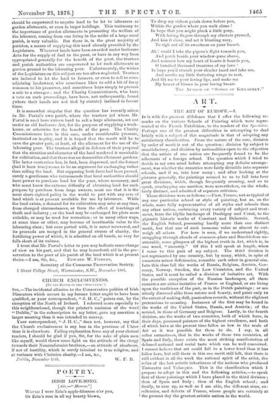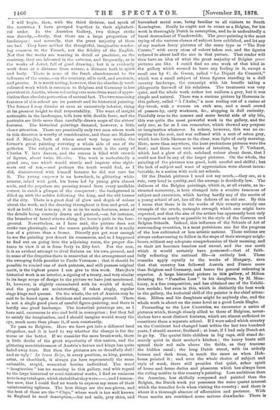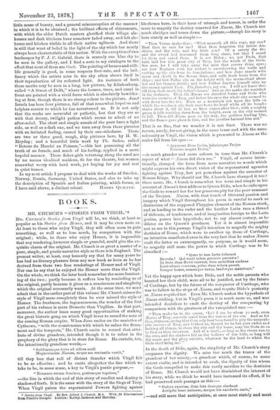A R T.
THE ART OF EUROPE.—I.
IT is with the greatest diffidence that I offer the following re- marks on the various Schools of Painting which were repre- sented at the French Exhibition, to the readers of the Spectator. Perhaps one of the greatest difficulties in attempting to deal briefly with a subject of this magnitude is that of adopting any satisfactory classification. From the nature of the case, division by order of merit is out of the question ; division by subject is unsatisfactory, and division by nationalities open to the objection that the artists of one nation are frequently found to be the adherents of a foreign school. The question which I tried to- decide in my own mind before attempting any definite arrange- ment, was whether the countries were fairly divisible into separate schools, and if so, into how many ; and after looking at the pictures generally, the paintings seemed to us to fall into four great divisions, which, though frequently crossing, and so to- speak, overlapping one another, were nevertheless, on the whole, fairly distinct, and admitted of separate criticism.
These divisions were as follows :—First, France, not as typical of any one particular school or style of painting, but as, on the whole, more fully representative of all styles and schools than any other nation, embracing every variety of subject and treat- ment, from the idyllic landscape of Daubigny and Corot, to the gigantic historic works of Constant and Delacroix. Second, the English School, possessing hardly more than one distinct merit, but that one of such immense value as almost to out- weigh all others. For here is seen, if we understand rightly, struggling through clouds of common-place and Bumbledom un- utterable, some glimpses of the highest truth in Art, which is, in one word, " sincerity." Of this I will speak at length, when I come to this part of my subject. The third division is not represented by one country, but by many, which, in spite of numerous minor deficiencies, resemble each other in general aim. Into this class fall the works of Russia, Belgium, Austria, Ger- many, Norway, Sweden, the Low Countries, and the United States, and it must be called a division of imitative art. With the possible exception of the Russian landscapes, all these countries are either imitative of France or England, or are living upon the traditions of the past, as in the Dutch paintings ; or are utterly divorced alike from nature and beauty, and paint only to the extent of making dull, passionless records, without the slightest pretensions to meaning. Instances of the first may be found in the works of the United States, Russia, and Austria ; of the second, in those of Germany and Belgium. Lastly, in the fourth division, are the works of two countries, both of which have, in their days, possessed painters of the highest excellence, and both of which have at the present time fallen as low in the scale of Art as it was possible for them to do. I say, in all sober earnestness, that in the works of these two countries, of Spain and Italy, there exists the most striking manifestation of debased national and social taste which can be well conceived. I cannot believe that art could fall to a lower level than it has fallen here, but still there is this one merit still left, that there is still evident in all the work the national spirit of the artist, the relics of the lost artistic inheritance of the nations who produced Tintoretto and Velasquez. This is the classification which I propose to adopt in this and the following articles,—to speak first of those paintings which I have placed in the third division ; then of Spain and Italy ; then of the English school ; and finally, to sum up, as well as I am able, the different aims, ex- cellencies, and defects of France, whose people are certainly at the present day the greatest artistic nation in the world.
I will begin, then, with the third division, and speak of the countries I have grouped together in their alphabeti- cal order. In the Austrian Gallery, two things strike one directly,—firstly, that there are a large proportion of landscapes ; and secondly, that the great majority of them are bad. They have neither the thoughtful, imaginative render- ing common to the French, nor the fidelity of the English. Not that the works are wanting in detail or precision, on the contrary, they are laboured in the extreme, and frequently, as in the works of Jettel, full of good drawing ; but it is evidently work done at a distance from nature, a distance both in spirit and body. There is none of the frank abandonment to the influence of the scene,—on the contrary, all is cold, and academic,
and precise. It is worth noting, however, that the absolutely mud-
coloured work which is common to Belgium and Germany is less prevalent in Austria, whose colouring errs more from want of appre- ciation than absolute perversion of natural fact. The two remaining features of this school are its portrait and its historical painting. The former I may dismiss at once as excessively inferior, rising at its greatest height to dull respectability. The want of insight noticeable in the landscapes, tells here with double force, and the portraits are little more than carefully-drawn maps of the sitters' features. The historical paintings demand, however, a little closer attention. There are practically only two men whose work in this direction is worthy of consideration, and these are Makaert and J. Matejko, both of whom send very large works, the former's great painting covering a whole side of one of the galleries. The subject of this enormous work is the entry of Charles V. into Anvers, and the canvas is filled with crowds of figures, about twice life-size. The work is undoubtedly a grand one, one which would startle and impress nine sight- seers out of ten,—and perhaps the tenth would feel, as I did, discontented with himself because he did not care for it. The young emperor is on horseback, in glittering white armour, inlaid with gold, his horse led by young girls almost nude, and the populace are pressing round from every available corner, to catch a glimpse of the conqueror ; the background is filled up with the nobles following the king, and the old houses of the city. There is a great deal of glow and depth of colour about the work, and the drawing throughout is firm and good, as well as bold ; that is to say, it is so in its main features, some of the details being coarsely drawn and painted,—as, for instance, the branches of laurel strewn along the horse's path in the fore- ground. Nevertheless, as I have said, the picture does not strike one pleasingly, and the reason probably is that it is really less of a picture than a fresco. Directly you get near enough to see the painting you detect its coarseness, and as I happened to find out on going into the adjoining room, the proper dis- tance to view it at is from forty to fifty feet. For the rest, it is an evident attempt to rival Rubens on his own ground, and in some of the draperies there is somewhat of the arrangement and the sweeping folds peculiar to Paolo Veronese ; that it should be possible to remind one of such painters, and still possess original merit, is the highest praise I can give to this work. Matejko's historical work is an interior, a signing of a treaty, and very similar in its large scope of design to the picture we have just mentioned.
It, however, is slightly encumbered with its wealth of detail, and the people are uninteresting, if taken singly, regular stage kings and queens. On the whole, the art of Austria may be said to be based upon a fictitious and uncertain ground. There is not a single good piece of careful figure-painting, and there is
hardly one good landscape. The historical paintings are, as I have said, enormous in size and bold in conception ; but they fail to satisfy the imagination, and I should imagine would weary the eye, much more than please it, if seen constantly.
To pass to Belgium. Here we have got into a different land altogether, and it is hard to say whether the change is for the worse or the better. If we consider the mere brushwork, there is little doubt of the great superiority of this nation, and the glittering meretriciousness of Austria's heroes and kings has quite faded away here. But then the pictures are so dreadfully dull! and so ugly ! Le brave Beige, in every position, as king, patriot, actor, or shoeblack, is always (as here represented) the same estimable, stupid, somewhat bovine individual. The word " imagination " has no meaning in this gallery, and with regard to the large historical or semi-historical works, I find an ominous note in my catalogue, which stated that they were—, and I remem- ber now, that I could find no words to express my sense of their uninteresting ugliness. The best things are the sea-pieces, and the best of those are the " Clays," whose work is too well known in England to need description,—his red sails, grey skies, and
burnished metal seas, being familiar to all visitors to South Kensington. Really he ought not to count as a Belgian, for his work is thoroughly Dutch in conception, and he is undoubtedly a lineal descendant of Vandervelde. The genre painting is the most trying of the various classes of subject here exhibited, and let any of my readers fancy pictures of the same type as " The New Curate," with every atom of colour taken out, and the figures reduced to about half the size in that picture. That reader will then have an idea of what the great majority of Belgian genre pictures are like. I could find no one work of that kind in the gallery which seemed to have any feeling in it, except a small one by C. de Greux, called " Le DCpart du Conscrit," which was a small subject of three figures standing in a dull country landscape, the conscript with his bundle taking a phlegmatic farewell of his relations. The treatment was very quiet, and the whole work rather too uniform a grey, but it was simple and natural. There was a curious picture by Hermans in this gallery, called " A l'Aube," a man reeling out of a casino at day-break, with a woman on each arm, and a small crowd of passersby, early workmen, &c., stopping in dull curiosity. Painfully true to the coarser and more brutal side of city life, this was quite the most powerful work in the gallery, and the only one, as far as I can remember, which showed any purpose or imagination whatever. In colour, however, this was no ex- ception to the rest, and was suffused with a sort of ashen grey, which bore little likeness to the clear, wan light of early morning. Here, more than anywhere, the least pretentious pictures were the best ; and there were two works of interiors, by P. Verhaert, which had a glow of rich, subdued colour about them, that I could not find in any of the larger pictures. On the whole, the painting of the pictures was good, both careful and skilful ; but the lack of subject and want of appreciation were almost incon- ceivable, in a nation with such art schools.
Of the Danish pictures I need not say much,—they are, as a rule, very level in quality, and the average is decidedly low. The dullness of the Belgian paintings, which is, at all events, an in- structed monotony, is here changed into a sombre tameness of subject and execution, which having hardly any of the merits of a young school of art, has all the defects of an old one. By this I mean that there is in the works of this country scarcely one example of the crude, untaught strength which one might have expected, and that the aim of the artists has apparently been only to approach as nearly as possible to the style of the German and Belgian Schools. Indeed, this influence of the Schools of Art of surrounding countries, is a most pernicious one for the progress of the less cultivated or less artistic nations. These nations are always endeavouring to follow in the steps of their stronger neigh- bours, without any adequate comprehension of their meaning, and so their art becomes baseless and unreal, and the one merit which it would certainly have possessed—that of faith- fully reflecting the national life—is entirely lost. These remarks apply equally to the works of Hungary, save that that country has followed Austria and France more than Belgium and Germany, and hence the general colouring is superior. A large historical picture in this gallery, of Milton dictating the "Paradise Lost" to his daughters, by M. Mun- ktiesy, is a fine composition, and has obtained one of the Exhibi- tion medals ; but even in this, which is distinctly the best work in the gallery, the technical skill of the painter is the chief attrac- tion. Milton and his daughters might be anybody else, and the whole work is about on the same level as a good Louis Haghe.
Proceeding to the Low Countries, we encounter a series of pictures which, though closely allied to those of Belgium, never- theless have most distinct features, which are almost sufficient to constitute them a separate school. If I were asked which country on the Continent had changed least within the last two hundred years, I should answer, Stolland ; at least, if I had only Dutch art to go by. The quaint little children in big caps, still stand de- murely quiet in their mother's kitchen ; the heavy boats still spread their red sails above the fields, as they traverse the hidden canal ; the long Dutch street, with its orderly houses and dark trees, is much the same as when Hob- bema painted it ; and over the whole choice of subject and style of work, there still presides that quiet, sober spirit of home and home duties and pleasures which has always been the riling motive in this country's painting. Less ambitious than the Austrian, less skilfully composed and painted than the Belgian, the Dutch work yet possesses the same quaint interest which the traveller feels when visiting the country ; and there is about it a thorough absence of affectation and pretence. With these merits are combined some serious drawbacks. There is little sense of beauty, and a general misconception of the manner in which it is to be obtained ; the brilliant effects of chiaroscuro, with which the older Dutch masters glorified their village ale- houses and dark kitchens have somehow faded away, and left ale- house and kitchen visible in all their native ugliness. And there is still that want of belief in the light of the sky which has nearly always been characteristic of this nation. With the exception of two landscapes by P. J. C. Gabriel, there is scarcely one blue sky to be seen in the gallery, and I find a note in my catalogue to the effect that most of them are blade. The painting of houses and still- life generally is good, in some respects first-rate, and the bril- liancy which the artists miss in the sky often shows itself in their reproduction of its reflected light. An instance of both these merits may be seen in a long, low picture, by Klinkenburg, called "A Street of Delft," where the houses, trees, and canal in front are painted with a vivid force which is absolutely bewilder. ing at first, though there is no strong colour in the picture. Josef Israels has here four pictures, full of that somewhat hopel'ss and helpless sorrow to which he has accustomed us. It is not only that the works are mournful or pathetic, but that they are so with that dreary, twilight pathos which seems to admit of no after-relief. The short and simple annals of the poor have a light side, as well as a dark one, and we turn away from these pictures with an irritated feeling, caused by their one-sidedness. There are two or three good, rough, ship pictures here, by II. W. Meydag ; and a beautiful little work by Ph. Sadee, called " Retour du Marchd an Poisson,"—this last possessing all the truth of an Israels, and much of his feeling, applied in a more hopeful manner. These fisher-girls returning along the sand are by no means idealised maidens, fit for the theatre, but women somewhat weary with hard work, yet hoping for joy and rest in quiet homes.
In my next article I propose to deal with the works of Sweden, Norway, Russia, Germany, United States, and also to take up the description of Spanish and Italian painting, which forms, as I have said above, a distinct school. HAnnv QuiLTEn.




































 Previous page
Previous page